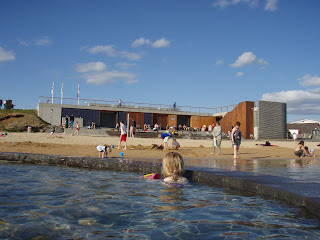That’s right – tonight is my last night in Akureyri before heading back to Reykjavík to board the Bjarni Saemundsson and set off for two weeks of shrimp surveying. There’s some basic information about the ship here. There’s also a link that is supposed to show locations of research vessels which might be updated along the way and give you an idea of where I am. I know that the survey generally focuses on waters in the north of Iceland – Hreiðar, who has gone on the survey before, says sometimes they even make it to the waters near Greenland and trawl in areas where there aren’t too many icebergs. I’ll be gone for two weeks: we leave on the 16th and get back on the 31st, so probably no news from me here or otherwise until I return.
So the real question you’re asking: shrimp? Aren’t you supposed to be studying cod? Well, yes. But it turns out that the annual groundfish surveys aren’t held during the time I’m in Iceland, but the shrimp survey is going on now, and will give me the idea for how the surveys are conducted. Because despite the huge amount of complexity in the ecosystem here, the management strategy is fairly straightforward: they take a census of the population, and then recommend catching a certain percentage of the fishable stock. Since shrimp and cod are both managed under this same quota system, this will give me a chance to see how the surveys are conducted. Also, since shrimp nets are so small, this survey will also catch a lot of fish along with the shrimp and it sounds like I’ll have a chance to see plenty of cod too.
I’m intrigued by how simple this management strategy seems but in practice, of course, this is a huge undertaking: for cod, the survey includes trawling over 500 sites using five different ships, both in the fall and the spring, and looking not just at the total number of individuals, but at the age and size of each. The survey data is then combined with data collected based on commercial catches (from lots of sampling like I went along to the fish processing plant to help with) and plugged into an algorithm to estimate the numbers and size of each year-class of fish. Since the survey collects data on fish too young to be caught, they know in advance how big the upcoming class of fishable stock will be and can make recommendations based on that. The key to a quota system is to base the quota on highly accurate data and then to enforce it strictly. The enforcement is pretty much separate from the science side of things, but this will also give me a chance to see how much data goes into the population analyses (although, since shrimp aren’t quite as commercially important as cod, it’s also not quite as extensively studied).
Another reason for learning about shrimp is that, as it turns out, studying the cod fishery – both in Iceland and, I suspect, pretty much everywhere – means learning about all the things that fit in with the cod, both in the ecosystem and in the social and political systems. Ecosystem interactions have become a big focus of fisheries research over the past decade or so, looking at how different species interact, how ocean chemistry and currents and temperatures affect the fish, how changes in the bottom environment affect habitat quality and the fish who use the habitat as protection as eggs and juveniles. Since cod are a major predator and eat voraciously, the success of the cod population is interdependent with the success of their prey – capelin, a pelagic fish, is their favorite food, but they also eat shrimp and Norway lobster and other crustaceans and even other cod. Management then ends up making calculations about how much of each species to catch based on factors like the fact that cod get more nutrition per weight for capelin than for crustaceans and that the cod, per weight, is worth more than capelin but less than Norway lobster in deciding how to set the quotas. It’s a tricky business, and though there have been innumerable studies, of which I’ve only read a small proportion, I don’t think there’s any way to strike that perfect balance with quotas. In any case, shrimp populations are often heavily influenced by cod, so even with no other reason, the shrimp survey will be interesting for the sense of multispecies interactions.
So I think that’s all I have until I come back. In case you want to see more of my adventures even while I’m gone, the most astute of blog-readers might have already noticed the link on the side: I now have some additional pictures on a separate site that go along with some of the things I’ve previously written about, and also some exploring around in the Akureyri area today. More news in a few weeks!




































